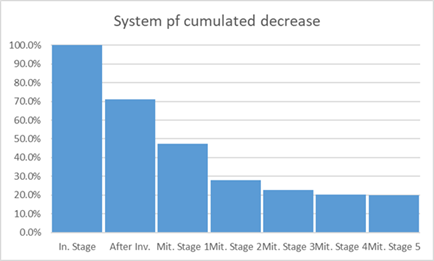Tailings Dam Risk Mitigation Through Risk-Informed Decision-Making is the title of our Planning for Closure 2022 paper.
Risk-informed Decision-making Supports Rational and Sensible Risk Mitigation
This blogpost shows how risk-informed decision-making (RIDM) using ORE2_Tailings™ supports rational and sensible risk mitigation selection. This is a requirement of the Global Industry Standard on Tailings Management (GISTM). We use an anonymized case report to preserve confidentiality.
To support rational risk mitigation roadmaps, we first test each possible single mitigative alternative and chain of possible mitigation steps in comparison to the worldwide benchmark failure rate. Then, we split each alternative’s causality between the dam itself and its ancillary water system, including possible necessary creek protection. The goal is to understand where we can apply optimum actions. This helps to evaluate the ratio between the annualized risk decrease and the mitigative capital expenditures for each mitigation alternative.
Furthermore, for each mitigation alternative and stage, we can evaluate the risk abatement “efficiency.” In the end, one can select the “optimal” roadmap considering constructional and regulatory constraints. The RIDM roadmap allows decisionmakers to select a defensible mitigation level (GISTM As Low As Reasonably Practicable (ALARP) or better). RIDM fosters healthy and rational technical and risk perception discussion related to the desired level of risk mitigation, based on GISTM ALARP. One can use RIDM to foster healthy discussions with regulators and insurers as needed.
Dam Case Study
The dam we use as an example is inactive and parallel to a valley bottom. An unprotected creek runs at its toe and the engineers considered its bed to offer sufficient protection against a 1/500 flood event. Beyond that flood, there will, of course, be progressive erosion of the dam toe. The dam has an upstream construction method. It has diversion ditches and drainage systems capable of carrying the 1/100 return. The area is not seismic, and there is consensus that the material is draining and not liquefiable. The original engineers designed the spillway for the 1/500 event; however, its present conditions do not allow passing more than the 1/100 return flood, as the dam had to be reinforced after past instabilities.
Nevertheless, the estimated annualized system probability of failure (pf) of 1.07*10-2 (appx. 1.1%) per year places the dam much higher than the worldwide benchmark’s highest value. In other words, the dam is more hazardous than the worldwide benchmark. Estimated failure consequences (C) are evaluated at approximately $2B due to the presence of inhabitants, housing, infrastructure, river and a relatively pristine environment downstream.
The Owner and Dam’s Engineer of Record Request
Given the pf and C, the dam risk is corporately and societally intolerable. In addition, it falls in the “extreme” consequences, according to the GISTM. The dam also represents a corporate strategic risk following the tolerance threshold comparison. Thus, the owner and engineer of record (EoR) want to mitigate its risks. We produced what-if mitigation scenarios to support RIDM.
The EoR developed a number of possible mitigative stages increasing from minimal repairs to significant reinforcement of the overall system. In total, the EoR prepared six alternatives. The process consisted in systematically evaluating the risks for each mitigative stage, the related capital expenditure and deriving risk abatement-mitigative investment graphs to determine the ALARP point.
Tailings Dam Mitigation Risk-informed Decision-making
Figure 1 displays each alternative’s causality split between the dam vs. ancillary water system, including the creek. These jointly cause the annualized system pf. The graph also shows that the ancillary water management facilities and the creek are the preponderant failure causality for alternatives 1 to 4. The dam’s pf would drive alternatives 5 and 6.





